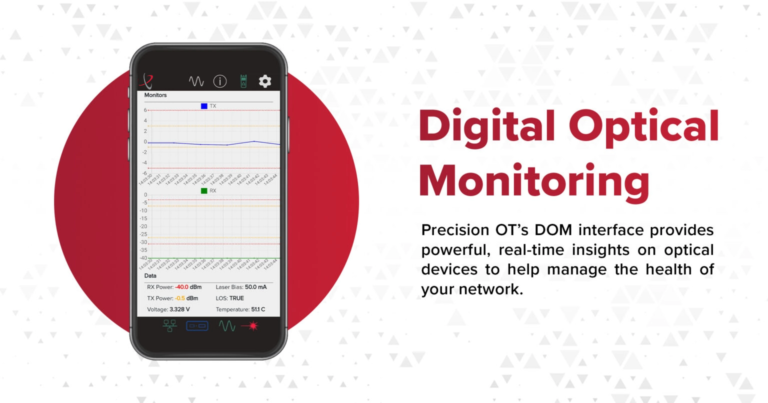
Digital Optical Monitoring: Out in the Field, It’s All About the Optics

Digital Optical Monitoring (DOM) is a technology that allows technicians to monitor the health of individual optical transceivers in real time. In this blog, we unveil our recent developments around DOM and how they can save network operators money.
“Good things come in pairs.” It’s an old saying that we think is especially true of the optical networking space, particularly around monitoring and maintenance. But what exactly do we mean?
In our last blog, we talked about Lightseer, the industry’s first technology for monitoring and analyzing physical layers of optical software-defined networks (SDNs). It’s basically a tool for system-wide optical monitoring that can also recommend configuration changes to improve the efficiency of your operations. So, what is its ideal pairing?
Enter Digital Optical Monitoring (DOM), a technology that allows technicians to monitor the health of individual optical transceivers in real time. In conjunction with a monitoring system like Lightseer, DOM is a vital tool in both the isolation and prevention of faults in the field before they result in downtime. Think of it like pairing the right wine with your main course – both are fine as standalones but offer greater impact when used together.
You Get What You Pay For, But Do You Need All of It?
In our field, everyone knows the name of the game is preventive versus reactive maintenance. When it comes to SFP and SFP+ optics, DOM enables network engineers to monitor certain transceiver operating parameters in real time like temperature, supply voltage and the transmit and receive power of the module. Because constant performance monitoring can improve troubleshooting capabilities, DOM compatibility is a must-have line item when purchasing transceivers.
While everyone can agree on the importance of DOM to the overall health of the network, many network engineers are unfortunately spending more money than they should on diagnostic equipment needed to leverage that data. Our key contention here is that, in many cases, operators are investing in tools with extraneous features that their technicians in the field do not really need on a daily basis. That money is better saved and used elsewhere.
When it comes to installing, monitoring and troubleshooting optics, there is no shortage of tools out there on the market right now. For example, a typical setup for testing transmitter power and receiver sensitivity could include a type of variable optical attenuator, optical power meter modules and a multiple application platform (MAP) mainframe box. At the same time, it’s also possible to run other tests on SFP and SFP+ optics with a fiber optic inspection microscope, cleaning supplies, loopback plugs and a mainframe. Moreover, when it comes to testing the fiber itself, suddenly a whole variety of different types of handheld and standalone OTDR platforms enter the mix. With so many different tools available for specific situations, network operators and their engineers can quickly find themselves going down an expensive rabbit hole.
Here’s what we believe. Yes, there can be times when a plethora of expensive tools is needed. But if there are ways to simplify the equipment needed and reduce costs at the same time, why not pursue them?
Precision OT’s Bluetooth Advancement
For the technicians out in the field, running checks and validation at the time of install, there is a simpler and less expensive way for them to get the job done right – the first time. If you have been following our blog for a while, you might already know that we are big believers in pairing cutting-edge technology with ease of use. In many ways, mobility is the result of such initiatives.
In the latter half of 2019, we unveiled our TN100-S-BT portable, Bluetooth-enabled tuning module for 1G SFP and 10G SFP+ optics. It allows for standard ITU C-Band 50GHz and 100Ghz channel configuration on the go. It also included our first-ever mobile tuning application, which is compatible with iOS and Android devices. In one swoop, we provided a way for network technicians to free themselves from the need for a computer connection to tune their equipment.
We are now pleased to announce that we’re once again leveraging Bluetooth technology combined with our tuning box and mobile app to provide DOM functionality for technicians in the field. As before, this move is in direct response to our customers who tell us that it would be simpler to use their mobile devices for vital functions instead of expensive kits that have features beyond what they need at the time. It’s not that we’re taking away from the need for these other products – they certainly have their place in the network engineer’s toolkit. Instead, we are offering a simpler, less expensive alternative that can support the vital, everyday needs of technicians leveraging DOM for infield debugging.
In many ways, this move is the first step in transforming our tuning box into more of an overall technician optical tool…a handheld test device of sorts. Think back to our pairing analogy. If Lightseer monitors and reports on critical analytics across your entire network, our Bluetooth tuning box can now give you instantaneous, localized optical monitoring. With just your mobile device and our handheld box, you can see the optical information you need regarding your transceivers onscreen. The two make a winning combination for overall network health.
With additional functionality for this box in our technology roadmap, we are dedicated to making it as easy as possible to leverage our innovations. We’re not just transceiver manufacturers after all, but a provider of tools, knowledge and expertise that can help network operators build and run the networks they require.
Interested in how we can support your DOM needs or what else is in store for our Bluetooth®-enabled equipment? Reach out!






